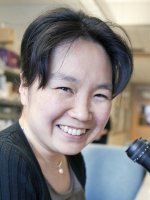Asymmetric stem-cell division in Drosophila male germline
to

Yukiko Yamashita, Ph.D.
Associate Professor
HHMI Investigator
University of Michigan, Ann Arbor
Summary
Adult stem cells continuously supply highly differentiated but short-lived cells, such as blood, skin, intestinal epithelium, and sperm cells, throughout life. To maintain the balance between stem cells and differentiating cells – a failure of which may lead to tumorigenesis through excess self-renewal or tissue degeneration through excess differentiation – many stem cells have the potential to divide asymmetrically so that each division produces one stem cell and one differentiating cell.
Drosophila male germline stem cells (GSCs) serve as an ideal model system to study stem-cell behavior. They reside in the stem-cell niche, which specifies stem-cell identity by sending essential signal(s). Stem cells have elaborate cellular mechanisms to ensure the asymmetric outcome of the division, producing one stem cell and one differentiating cell, which is the key to tissue homeostasis.
Whereas the stem-cell niche provides essential signals for stem-cell identity and proliferation, it is not well known how the niche signal is limited to stem cells, while other cells in proximity are not misspecified by the niche signaling. Here we show that in Drosophila testis, GSCs extend microtubule-based nanotubes into the hub cells, the major component of the stem-cell niche. We further demonstrate that the nanotube mediates decapentaplegic (Dpp) signaling between the hub and GSCs. We propose that confinement of the Dpp signaling to a spatially limited surface area of the nanotube allows privileged reception of niche-derived signals by stem cells.
This page was last updated on Wednesday, August 11, 2021